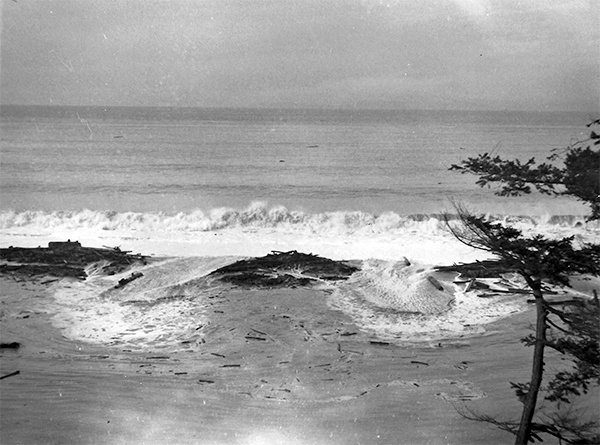by John Maxwell
for the Sequim Gazette
Editor’s note: This is the ninth in a monthly series about the Dungeness National Wildlife Refuge, past and present. — MD
How does Mother Nature affect the Dungeness Spit?
Let me count the ways, starting at the beginning. Current estimates are that the spit is about 6,000 years old, older than the first pyramids in Egypt. But its origin goes back to the last ice age when the Cordilleran glacier, a mile deep river of ice, came south.
This particular glacier bulldozed millions of tons of rocks, sand and clay south out of the mountains of British Columbia and onto our shores.
Naturalist John Muir described the evidence of its passing when he saw in Victoria Harbor, “The shores also of the harbor are strikingly grooved and scratched and in every way as glacial in all their characteristics as those of new-born glacial lakes.”
When the ice melted some 10,000-12,000 years ago, it deposited all those millions of tons of rock, gravel, silt and sand on the southern shore of the Strait of Juan de Fuca and on down into Puget Sound, forming the highly unstable bluffs of “glacial till” we see today.
Judging by the present rate of erosion, the bluffs originally extended about a mile farther north into the strait. Ten thousand years of erosion cut them back to where they are now.
What happened to all the eroded material? Waves, winds and ocean currents carried it eastward through the strait, eventually dropping it to form the spit. Three-dimensional bathymetric charts show shallows extending a mile north into the strait to where the bluffs and spit lay originally.
On the move
The spit still is growing and changing. The New Dungeness Lighthouse was built in 1857 about 900 feet from the end; since then the spit has grown, placing the light almost half a mile from the end. There also are several smaller ancillary spits like Graveyard Spit sprouting off the bay side of the main spit.
Dungeness Spit always is on the move, both easterly into deeper water, and southerly (and sometimes easterly). However, with the time spans involved, you and I probably won’t notice much change even if we live to be 100.
The bluffs to the west are the source of the spit. If they stopped eroding and adding material to the beach that is subsequently carried to the spit, the spit itself would stop growing and eventually start shrinking. In other words, no bluff erosion equals no spit.
From time to time people try to build homes on top of the bluffs, as close to the edge as possible for the best view. According to Washington State Department of Natural Resources geologist David Parks, this is not a good idea. Armoring the bluff base with sea walls or riprap is an even worse idea; it actually increases the erosion, undercutting the bluff until it collapses.
If you want a house with a view of the strait and Vancouver Island, you would be well advised to build at least a kilometer (two-thirds of a mile) back from the bluff edge. Then the house may outlive you.
Weather works
Bluff erosion is only part of the story. It is not at all unusual for winter storms combined with high tides to breach the spit, turning the light station into an island for a brief time until the spit heals itself.
A fierce winter storm in 1990 blew down over 100 trees on the bluff, sloughed 30 feet off of the bluff itself, took out 15 feet at the base of the spit and breached it in several places.
A 30-foot tsunami would completely engulf both spit and light station, destroying everything. Even then, the spit eventually would repair itself.
Remember that the last tsunami happened 157 years before the lighthouse was built, but in 1857 no one knew. Geologists tell us there have been 41 subduction-zone earthquakes and tsunamis since the last ice age and that we are overdue for the next one. Now we do know.
Nature affects the Dungeness Spit in other ways as well. The alongshore beds of eelgrass are the true heart and soul of the refuge, providing winter forage for waterfowl and year-around shelter and food for countless organisms from microscopic to forage fish and young salmon.
Storms can damage those beds, in turn affecting the wildlife. Lightning can start fires in the grass and driftwood along the spine of the spit, destroying nesting grounds and killing sea birds and seal pups.
Climate change can affect ocean currents and wildlife migration patterns. Even in the 10,000 years since the last ice age, the climate has not remained stable and unchanging. A “little ice age” in the 14th century profoundly impacted the Northern Hemisphere.
In Europe it set the stage for the Black Death plague, drove the Vikings out of their Greenland settlements and allowed the Inuit of northern Canada to move south into Nova Scotia. It probably affected life here as well.
Thus, even before you turn to threats caused by human activity (and they are many), you may be sure that Mother Nature has profoundly affected the spit and its dependent wildlife over the 6,000 years of its existence.
What will Dungeness Spit look like a hundred years from now, or a thousand or 10,000? You can be sure it will change, especially the longer you go into the future.
Eventually Dungeness Spit as we know and love it probably will disappear completely.
Enjoy it while you may!
John Maxwell is a historian for the Dungeness National Wildlife Refuge.



